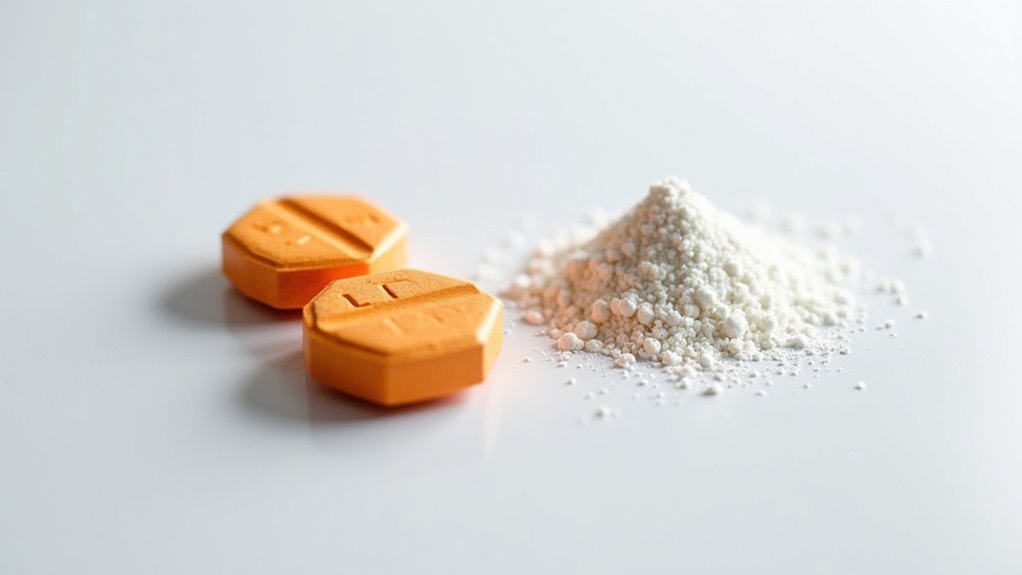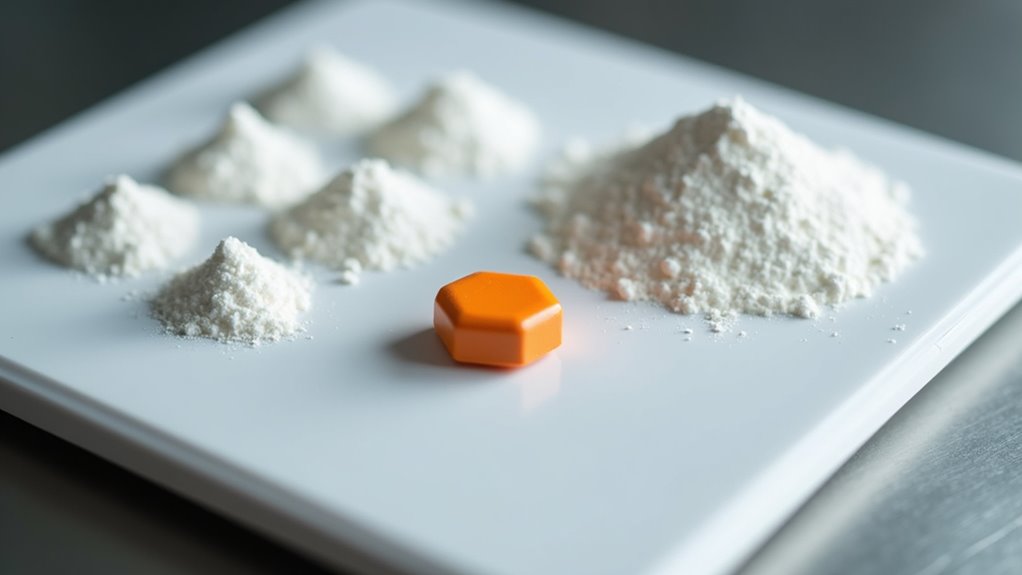Suboxone contains two primary active ingredients: buprenorphine (a partial opioid agonist) and naloxone (an opioid antagonist) in a precise 4:1 ratio. You’ll find these components carefully formulated in different strength combinations, including 2mg/0.5mg, 4mg/1mg, 8mg/2mg, and 12mg/3mg options. The medication utilizes sublingual administration, with buprenorphine managing withdrawal symptoms while naloxone serves as an abuse deterrent. Understanding the specific mechanisms of these ingredients reveals their pivotal therapeutic roles.
Core Active Components of Suboxone

The core active components of Suboxone consist of two primary pharmaceutical ingredients working in concert: buprenorphine hydrochloride and naloxone hydrochloride dihydrate.
This combination medication rationale pairs a partial opioid agonist (buprenorphine) with an opioid antagonist (naloxone) to create a safeguarded treatment approach. You’ll find these components precisely formulated in consistent ratios across multiple dosage strengths: 2mg/0.5mg, 8mg/2mg, and 16mg/4mg tablets. The ratio between the ingredients is specifically maintained at 4 to 1 ratio, which ensures optimal therapeutic efficacy. The starting dose typically begins at 4 mg buprenorphine to initiate treatment safely.
The sublingual administration limitations are strategically designed – when taken as prescribed under the tongue, buprenorphine effectively reduces cravings while naloxone remains minimally bioavailable. However, if the medication is misused through injection, the naloxone component activates fully, triggering immediate withdrawal symptoms and thereby deterring abuse potential.
Understanding the 4:1 Ratio Formula

Building upon the active components described above, Suboxone’s distinctive 4:1 ratio represents a carefully engineered balance between buprenorphine and naloxone. This drug formulation rationale guarantees therapeutic effectiveness balance while incorporating critical safety mechanisms.
Suboxone’s precise 4:1 buprenorphine-naloxone ratio reflects sophisticated pharmaceutical engineering, balancing therapeutic benefits with built-in safeguards against misuse.
You’ll find this ratio maintained across all dosage strengths, from 2 mg/0.5 mg to 12 mg/3 mg combinations. The medication comes as an orange rectangular film with a white printed logo identifying the specific dosage strength.
- Each sublingual film contains precisely four parts buprenorphine to one part naloxone
- The ratio optimizes buprenorphine’s partial agonist effects while naloxone remains dormant
- If injected or swallowed, naloxone activates to block opioid effects
- Standardized proportions prevent manipulation of individual components
This fixed-ratio design delivers consistent therapeutic benefits while deterring misuse, making it a cornerstone of modern medication-assisted treatment for opioid dependence.
Inactive Ingredients and Their Purpose

Numerous inactive ingredients in Suboxone serve essential functions beyond simply housing the active compounds. You’ll find binding agents like povidone K30 and corn starch that maintain tablet structural integrity, while crospovidone optimizes tablet disintegration characteristics during sublingual administration.
To improve palatability, the formulation includes sweeteners such as maltitol and sucralose, combined with natural lemon/lime flavoring to mask unpleasant tastes. For stability, mannitol aids in moisture absorption prevention, while magnesium stearate guarantees consistent tablet dimensions.
pH regulators, including citric acid and sodium citrate, create a favorable environment for drug dissolution under the tongue. FD&C Yellow No.6 provides visual differentiation between dosage strengths, while lactose serves as a bulk filler to maintain proper tablet size and shape.
How Buprenorphine Works in the Body
Buprenorphine’s unique receptor binding properties make it highly effective for treating opioid use disorder.
You’ll find that it acts as a partial agonist at mu-opioid receptors, providing enough activation to prevent withdrawal symptoms while maintaining a ceiling effect that reduces overdose risk. The medication’s slow receptor dissociation contributes to its extended duration of action. Combined with behavioral therapies, it represents an advancement in medication-assisted treatment. The drug’s development emerged from evidence-based practices in clinical research.
The medication’s high receptor affinity allows it to block other opioids from binding, while its partial agonist properties deliver therapeutic benefits without the full effects of conventional opioids.
Receptor Binding Properties
The molecular dance between buprenorphine and opioid receptors represents a complex interplay of partial agonism and antagonism. The binding profile of buprenorphine shows high affinity for mu-opioid receptors (MOR) while simultaneously blocking kappa (KOR) and delta (DOR) receptors. This unique receptor occupancy creates a balanced therapeutic effect that helps manage opioid dependency while minimizing abuse potential. Beyond traditional opioid receptors, buprenorphine also interacts with ORL-1 receptors contributing to its distinctive pharmacological profile.
- Your brain’s MOR receptors receive partial stimulation, providing relief without full euphoric effects
- The medication firmly attaches to receptors, displacing other opioids like heroin or morphine
- Your KOR and DOR receptors remain blocked, reducing dysphoria and hyperalgesia
- The receptor binding creates a ceiling effect, limiting respiratory depression risks
This sophisticated mechanism enables buprenorphine to maintain neurochemical stability while providing therapeutic benefits with augmented safety compared to full agonists.
Partial Agonist Benefits
Five key mechanisms define buprenorphine’s partial agonist benefits in opioid use disorder treatment. You’ll experience reduced overdose risk through its ceiling effect on respiratory depression, while its high receptor affinity blocks other opioids. The medication delivers minimal cognitive impairment compared to full agonists, enabling improved quality of life during recovery. The medication can be administered through multiple routes including sublingual or buccal delivery for maximum effectiveness. As a partial opioid agonist, buprenorphine provides effective treatment without producing the intense euphoric effects of full opioids.
| Mechanism | Clinical Benefit |
|---|---|
| Ceiling Effect | Limits respiratory depression |
| Receptor Binding | Blocks dangerous opioids |
| Withdrawal Control | Stabilizes neural pathways |
| Craving Reduction | Prevents compulsive seeking |
| Abuse Prevention | Reduces euphoric response |
The Role of Naloxone as a Deterrent
Naloxone’s presence in Suboxone serves as a strategic deterrent against injection abuse by triggering immediate withdrawal symptoms if the medication is injected. When you inject Suboxone, the naloxone component becomes fully active, causing severe physical reactions including nausea, vomiting, and muscle aches. Clinical monitoring must be maintained throughout treatment due to the potential for abuse. In contrast, when you take Suboxone properly under your tongue, the naloxone remains minimally active, allowing the buprenorphine to work as intended for your treatment.
Injection Abuse Prevention Mechanism
Incorporated within Suboxone’s formulation, naloxone serves as a strategic deterrent against injection abuse through its opioid-antagonist properties. When you inject Suboxone, naloxone’s injection deterrence effectiveness relies on its ability to compete with buprenorphine for opioid receptors, potentially triggering withdrawal symptoms in opioid-dependent individuals. Though buprenorphine’s higher receptor affinity ultimately dominates, naloxone’s presence contributes to injection misuse reduction. Due to its properties, naloxone becomes extensively metabolized in liver during first-pass metabolism. Studies indicate that 46% of patients receiving maintenance therapy have attempted intravenous injection of buprenorphine.
Naloxone blocks opioid receptors within minutes of injection. Competition for receptor binding reduces euphoric effects. Withdrawal symptoms may occur within 30-40 minutes. Poor oral bioavailability guarantees minimal impact during prescribed sublingual use.
The combination’s pharmacodynamics demonstrate a sophisticated approach to abuse prevention, as naloxone’s antagonist properties remain clinically insignificant during proper sublingual administration while actively discouraging injection attempts.
Precipitated Withdrawal Protection
The protective mechanism of precipitated withdrawal in Suboxone’s formulation acts through naloxone’s unique pharmacological properties. When you take Suboxone as prescribed sublingually, naloxone’s pharmacokinetic limitations result in minimal systemic absorption. However, if you attempt injection or intranasal misuse, naloxone rapidly achieves high concentrations, triggering withdrawal. The medication’s peak plasma concentration occurs within 1-4 hours after proper sublingual administration. Over the counter availability of naloxone in all states helps ensure access to this life-saving medication.
| Route | Naloxone Effect | Clinical Outcome |
|---|---|---|
| Sublingual | Low bioavailability | Therapeutic buprenorphine action |
| Injection | High bioavailability | Precipitated withdrawal |
| Intranasal | Moderate-high bioavailability | Variable deterrence effects |
This built-in deterrent system relies on naloxone’s preferential μ-receptor binding during misuse scenarios. While tolerance and non-parenteral abuse can limit effectiveness, the 4:1 buprenorphine:naloxone ratio guarantees sufficient antagonist presence to discourage injection while maintaining therapeutic efficacy when taken properly.
Physical Characteristics and Tablet Design
Suboxone tablets feature a distinctive hexagonal shape with biconvex surfaces, tailored for sublingual administration. The tablet disintegration dynamics rely on an uncoated design that facilitates rapid dissolution under your tongue.
During the sublingual administration process, you’ll notice the tablet’s dual-layer structure containing both buprenorphine and naloxone components. The tablets come in two standard dosage strengths containing 2 mg or 8 mg of buprenorphine.
- Hexagonal tablets range from 6.5mm to 11mm in size, with larger dimensions corresponding to higher dosage strengths
- Debossed identifiers like “N2,” “N8,” or “N16” help you verify the correct dosage strength
- White, uncoated surfaces promote faster dissolution compared to coated alternatives
- Biconvex profile on both sides enhances contact with sublingual tissue for improved absorption
The tablet’s physical design incorporates specific excipients like lactose and mannitol to maintain structural integrity while ensuring proper disintegration when administered.
Different Strength Options Available
Suboxone’s distinct strength combinations allow you to match the ideal dosage to your specific treatment needs. You’ll find the medication available in four standard formulations, with buprenorphine-to-naloxone ratios carefully calibrated to maintain therapeutic efficacy while preventing misuse.
The physical dimensions and film thickness vary proportionally with strength, though all formulations retain the same distinctive orange color and rectangular shape for clear identification.
Standard Dosage Forms Available
Available in multiple standardized strengths, Suboxone’s formulations maintain a consistent 4:1 ratio of buprenorphine to naloxone across all dosage options. You’ll find Suboxone in two primary film options available: sublingual and buccal formulations. These specialized delivery methods offer distinct absorption advantages through their controlled-release mechanisms.
Sublingual films dissolve under your tongue, enabling rapid medication uptake through the oral mucosa. Buccal films adhere between your cheek and gum, providing an alternative absorption route. Both formulations guarantee precise dosing without the risk of splitting or dividing doses. Film designs incorporate abuse-deterrent properties while maintaining therapeutic efficacy.
The absence of tablet forms under the Suboxone brand name emphasizes the manufacturer’s commitment to controlled delivery systems that optimize treatment outcomes while minimizing misuse potential.
Choosing Appropriate Strength Levels
Building upon the established delivery systems, selecting the appropriate strength of Suboxone requires careful consideration of multiple standardized options. You’ll find common buprenorphine/naloxone combinations available in 2 mg/0.5 mg, 4 mg/1 mg, 8 mg/2 mg, 12 mg/3 mg, and 16 mg/4 mg formulations.
When shifting between formulations, it’s critical to understand that Zubsolv 5.7 mg/1.4 mg tablets provide equivalent buprenorphine exposure to Suboxone 8 mg/2 mg tablets.
Dosage escalation protocols typically begin with lower strengths (2 mg/0.5 mg) during induction, progressing to higher maintenance doses based on your clinical response. The 4:1 buprenorphine/naloxone ratio remains consistent across all strength options, maintaining overdose prevention mechanisms while accommodating individual patient needs through diverse delivery methods, including films and tablets.
Tablet Size Differences
The physical dimensions of buprenorphine/naloxone products vary considerably across different strength formulations, with each dosage level featuring distinct sizes to prevent medication errors. When considering film to tablet substitution, you’ll notice standardized film dimensions that correlate with specific strengths, while tablet sizes may differ between manufacturers.
- 2 mg/0.5 mg units represent the smallest film size, enabling precise dose adjustments during tapering
- 4 mg/1 mg and 8 mg/2 mg films feature progressively larger dimensions for clear differentiation
- 12 mg/3 mg films maintain the largest standardized size for higher-dose treatments
- Generic tablets exhibit varying shapes (round, hexagonal, oval) with manufacturer-specific dimensions
Understanding these dimensional differences is pivotal, as combining smaller units to achieve higher doses can lead to concentration mismatches and potential dosing errors. Your healthcare provider must approve any form changes between films and tablets.
Comparing Suboxone to Methadone Treatment
When comparing Suboxone and methadone treatments for opioid use disorder, several key pharmacological distinctions emerge. Suboxone’s buprenorphine component acts as a partial opioid agonist with a built-in ceiling effect, while methadone fully activates opioid receptors. This difference affects medication dosage requirements substantially methadone typically starts at 20-30mg daily and may increase to 60-120mg, while Suboxone begins at 2-4mg and stabilizes at 16-24mg daily.
Treatment frequency differences are notable in accessibility and administration. You’ll need daily clinic visits for methadone initially, whereas you can take Suboxone at home through prescribed sublingual tablets or films. Methadone’s longer half-life necessitates stricter tapering protocols, but Suboxone offers more flexible dose reduction options due to its partial agonist properties.
Safety Features and Abuse Prevention
Safety engineering within Suboxone combines buprenorphine and naloxone to create multiple layers of abuse deterrence. Evidence-based monitoring protocols enable clinicians to track patient compliance through regular urine screens and pill counts, while addressing age-specific abuse risks through tailored interventions.
The medication’s design incorporates sophisticated safety mechanisms that activate when misused. Sublingual film/tablet formulation resists tampering and prevents injection. Naloxone remains dormant when taken as directed but triggers withdrawal if injected. Buprenorphine’s ceiling effect limits respiratory depression and overdose potential. Built-in antagonist properties deter recreational use and diversion.
These features work alongside behavioral interventions and supervised dosing protocols to maintain treatment integrity. Clinical monitoring safeguards proper medication use while supporting long-term recovery through comprehensive support systems.
Proper Storage and Handling Guidelines
Proper storage and handling of Suboxone requires strict adherence to environmental controls that maintain medication stability and efficacy. You’ll need to store your medication at room temperature (59°F-86°F) in a dark, secure location away from direct sunlight and heat sources. Proper handling precautions include using airtight, opaque containers, preferably glass, to protect against light and moisture degradation.
For compliance monitoring protocols, regularly inspect your medication’s packaging for damage and maintain documentation during transport. When traveling, keep Suboxone in your carry-on luggage within locking cases. You’ll want to avoid storing it in bathrooms, kitchens, or vehicles where temperature and humidity fluctuate.
Remember to secure medications in locked cabinets, away from children and pets, and promptly replace any expired or compromised doses.
Frequently Asked Questions
Can Suboxone Ingredients Interact With Vitamins or Supplements I’m Taking?
You’ll need to be cautious about potential interactions with herbal supplements while taking Suboxone. The medication’s active ingredients can impact metabolism and absorption of certain vitamins and supplements.
Key concerns include interactions with CNS depressants like melatonin or valerian root, and timing of mineral supplements due to absorption competition. You should discuss your supplement regimen with your healthcare provider, as research on specific interactions is limited.
How Long Do Suboxone Ingredients Stay Detectable in Urine Tests?
Your Suboxone urinalysis detection timeline varies based on several factors. The primary ingredient, buprenorphine, typically remains detectable in urine for 3-10 days after your last dose, though it can extend up to 2 weeks if you’re a heavy user.
Naloxone, the other active ingredient, generally shows up for only 1-3 days. Factors affecting your Suboxone drug detection period include dosage amount, metabolism rate, and hydration levels.
Are Suboxone Ingredients Safe to Take During Pregnancy?
You should consult your healthcare provider about potential pregnancy risks before taking Suboxone during pregnancy. While buprenorphine alone has been studied in pregnant patients, there’s limited data on the combination with naloxone.
Long-term safety considerations aren’t fully established, though managed treatment is often preferred over untreated opioid dependence during pregnancy. Your doctor will need to carefully weigh individual benefits against possible risks for your specific situation.
Does Crushing or Splitting Suboxone Tablets Affect How the Ingredients Work?
Yes, crushing or splitting Suboxone tablets drastically alters their effectiveness. You’ll experience reduced bioavailability when you modify the tablets, as this disrupts their carefully designed sublingual delivery system.
The altered absorption rate can lead to unpredictable medication levels in your bloodstream, potentially triggering withdrawal symptoms or reducing therapeutic benefits. Moreover, crushing may activate the naloxone component prematurely, which could interfere with proper treatment outcomes and compromise your safety.
Can Certain Foods or Beverages Enhance or Reduce Suboxone’s Effectiveness?
Food and beverages can greatly impact your medication absorption rate. You should avoid consuming anything for at least 1 hour before and after taking Suboxone to guarantee ideal sublingual absorption.
Food-drug interactions can occur with acidic drinks, high-fat meals, and grapefruit products, potentially lessening effectiveness. Also, thick liquids or excessive saliva production from chewing gum might physically interfere with the tablet’s sublingual placement and dissolution.






